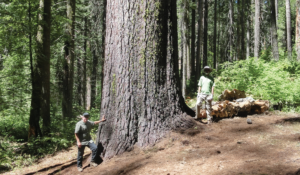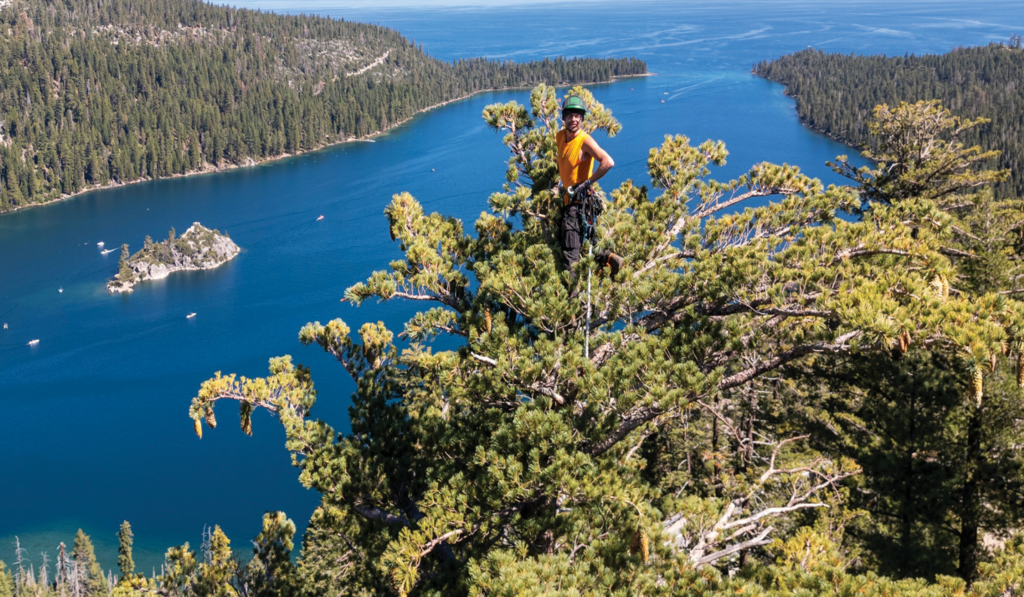World’s Largest Sugar Pine Discovered!

Alongside the sequoia and the redwood, California is home to the world’s most massive pine tree: the sugar pine. Mossy Creek Giant. Photo credit: Sugar Pine Foundation
By Judy Weiss, Sydney Furman
Have you ever heard of the sugar pine? Alongside the sequoia and the redwood, California is home to the world’s tallest and most massive pine tree: the sugar pine.
I became aware of the sugar pine through the names of the various state parks, a campground, businesses and more in the Lake Tahoe basin. I started wondering, where are they and what do they look like? Sadly, the sugar pine now makes up only 5% of the pines in the Tahoe basin, but they were once 25% of the pine trees there. Today, sugar pines can be difficult to find unless you really hunt for them. I have found them to be more plentiful outside of the Lake Tahoe basin and have fallen in love with them.
They are easily distinguishable from other pine trees because their cones are often more than 14 inches long and 4 to 6 inches in diameter—the longest of any cone-bearing tree, to me, resembling a cluster of grapes dangling from their massive sweeping branches. These pines typically grow between 100 and 200 feet tall, with trunks between 4 and 11 feet wide.
Just recently, on August 25, 2024, foresters Michael Taylor, Carl Casey and Martin Crawford measured a sugar pine in Yosemite National Park and found it to be the largest known pine in the world, with a volume of 5,761 cubic feet! Dubbed the “Mossy Creek Giant,” it stands 236 feet tall and 8.7 feet in diameter.

Seed collecting over Emerald Bay, Lake Tahoe, by the Sugar Pine Foundation. Photo credit: Sugar Pine Foundation
The sugar pine provides food and habitat for wildlife, stabilizes snow and soil, promotes forest diversity and health, and boosts resistance to wildfire. However, because they are one of the most prized commercial timbers on the Pacific Coast and they are also susceptible to blister rust (a disease caused by a non-native fungus), their numbers have plummeted.
This devastation hasn’t gone unnoticed and there is a foundation dedicated to returning them to their once-prominent state, the Sugar Pine Foundation. Fortunately, it is possible to save these gentle giants. About 3 to 5% of sugar pines are naturally resistant to blister rust. By identifying these trees and collecting their seeds, the Sugar Pine Foundation has planted over 200,000 blister rust-resistant trees and has restored nearly 4,000 acres
of sugar pines. You can help, too! Join a volunteer planting event, collect cones and seeds, and participate in outdoor excursions and fundraisers.
If you, like me and thousands of other tree-lovers, want to see more of these magnificent trees and help them make their comeback, visit SugarPineFoundation.org. The website also has an online shop to purchase seedlings, cones, clothing and more. Find perfect Christmas gifts for tree lovers!
Now that you know what a sugar pine is, try to spot as many as you can on your next trip to the mountains. They can be found in the mountain ranges of California, Oregon and northwestern Mexico. It’s a fun game while traveling with family and friends. See who can spot the most!

